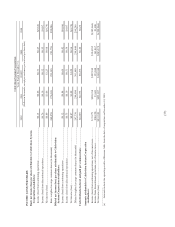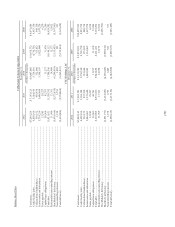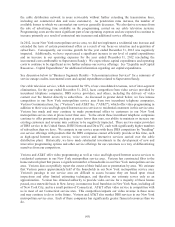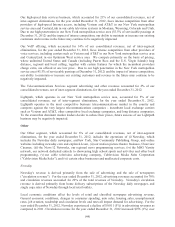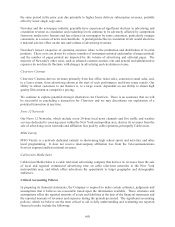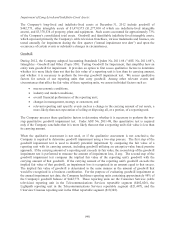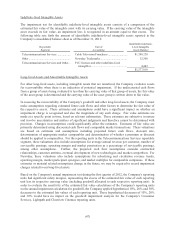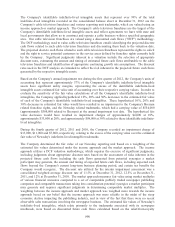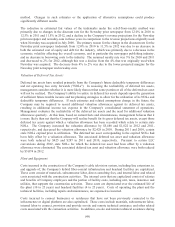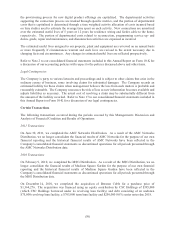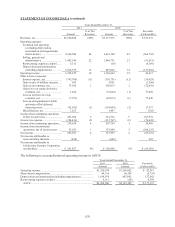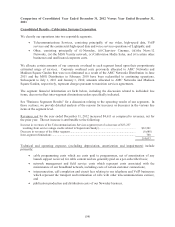Cablevision 2012 Annual Report Download - page 52
Download and view the complete annual report
Please find page 52 of the 2012 Cablevision annual report below. You can navigate through the pages in the report by either clicking on the pages listed below, or by using the keyword search tool below to find specific information within the annual report.
(46)
Impairment of Long-Lived and Indefinite-Lived Assets:
The Company's long-lived and indefinite-lived assets at December 31, 2012 include goodwill of
$442,773, other intangible assets of $1,479,575 ($1,277,010 of which are indefinite-lived intangible
assets), and $3,378,538 of property, plant and equipment. Such assets accounted for approximately 73%
of the Company's consolidated total assets. Goodwill and identifiable indefinite-lived intangible assets,
which represent primarily the Company's cable television franchises, various trademarks and licenses, are
tested annually for impairment during the first quarter ("annual impairment test date") and upon the
occurrence of certain events or substantive changes in circumstances.
Goodwill
During 2012, the Company adopted Accounting Standards Update No. 2011-08 ("ASU No. 2011-08"),
Intangibles - Goodwill and Other (Topic 350): Testing Goodwill for Impairment, that simplifies how an
entity tests goodwill for impairment. It provides an option to first assess qualitative factors to determine
whether it is more likely than not that the fair value of a reporting unit is less than its carrying amount,
and whether it is necessary to perform the two-step goodwill impairment test. We assess qualitative
factors for certain of our reporting units that carry goodwill. Among other relevant events and
circumstances that affect the fair value of these reporting units, we assess individual factors such as:
xmacroeconomic conditions;
xindustry and market conditions;
xoverall financial performance of the reporting unit;
xchanges in management, strategy or customers; and
xrelevant reporting unit specific events such as a change in the carrying amount of net assets, a
more-likely-than-not expectation of selling or disposing all, or a portion, of a reporting unit.
The Company assesses these qualitative factors to determine whether it is necessary to perform the two-
step quantitative goodwill impairment test. Under ASU No. 2011-08, this quantitative test is required
only if the Company concludes that it is more likely than not that a reporting unit's fair value is less than
its carrying amount.
When the qualitative assessment is not used, or if the qualitative assessment is not conclusive, the
Company is required to determine goodwill impairment using a two-step process. The first step of the
goodwill impairment test is used to identify potential impairment by comparing the fair value of a
reporting unit with its carrying amount, including goodwill utilizing an enterprise-value based premise
approach. If the carrying amount of a reporting unit exceeds its fair value, the second step of the goodwill
impairment test is performed to measure the amount of impairment loss, if any. The second step of the
goodwill impairment test compares the implied fair value of the reporting unit's goodwill with the
carrying amount of that goodwill. If the carrying amount of the reporting unit's goodwill exceeds the
implied fair value of that goodwill, an impairment loss is recognized in an amount equal to that excess.
The implied fair value of goodwill is determined in the same manner as the amount of goodwill that
would be recognized in a business combination. For the purpose of evaluating goodwill impairment at
the annual impairment test date, the Company had three reporting units containing approximately 98% of
the Company's goodwill balance of $442,773. These reporting units are the Consumer Services (cable
television) reporting unit in the Telecommunications Services reportable segment ($402,026), the
Lightpath reporting unit in the Telecommunications Services reportable segment ($21,487), and the
Clearview Cinemas reporting unit in the Other reportable segment ($10,348).



